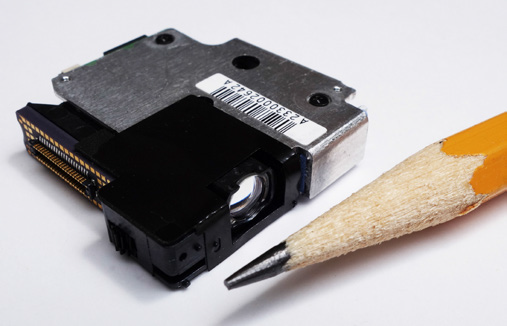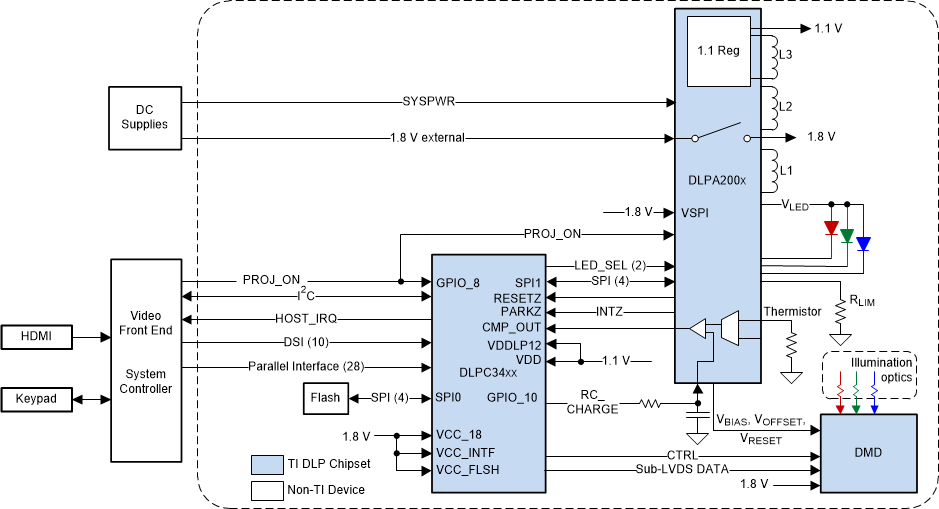DLPY011 September 2022 DLPC3430 , DLPC3432 , DLPC3433
- At a glance
- Authors
- 3
- Smartphone companion projectors: a big-screen experience, anywhere
- Smartphone companion projector benefits
- Technological advancements impacting smartphone companion projectors
- TI DLP Pico technology
- RGB LED illumination
- DLP Pico technology for smartphone companion projectors
- Smartphone companion projector design and tradeoffs
- Size and weight
- Brightness
- Resolution
- Battery life
- Connectivity options
- Product development and supply chain
- Conclusion
DLP Pico technology for smartphone companion projectors
DLP Pico technology enables smartphone companion projectors to achieve the optimal combination of performance, size and battery life. Table 1 describes five key features of DLP Pico technology and their associated benefits for smartphone companion projectors.
| Features | Benefits |
|---|---|
| High optical efficiency | DLP Pico DMDs contain reflective and polarization-agnostic aluminum micromirrors, which enable bright smartphone companion projectors with relatively low illumination power consumption. |
| Small size, high resolution | DLP Pico DMDs, with micromirror arrays as small as 0.2 inches in diagonal, create high-resolution displays in mobile accessory form factors. |
| High contrast | Optical modules designed with DLP Pico DMDs can achieve full on-and-off contrast ratios of over 1000-to-1, depending on system optical design trade-offs. Higher contrast enables projection displays with more vivid colors and darker blacks. |
| DLP IntelliBright™ algorithms | The DLP IntelliBright image-processing algorithm suite helps optimize image brightness, contrast and power consumption. For more information, see TI DLP IntelliBright Algorithms for the DLPC343x Controller. |
| Supplier ecosystem | A global supplier ecosystem of optical module manufacturers, system integrators and original design manufacturers (ODMs) eases the design process and enables product developers to go to market faster. |
A DLP Pico smartphone companion projector includes a DLP Pico chipset – a three-chip system comprises a DMD, a controller and a power-management integrated circuit (PMIC). Figure 6 demonstrates the small size of an optical module which includes a DMD, LED illumination, and optical and mechanical components. The controller and PMIC are typically located on a nearby PCB that drives the optical module with illumination power and DMD control signals.
 Figure 6 An ultra-compact DLP2010
(0.2-inch 854 x 480 resolution) optical module with approximate dimensions of 30
mm by 30 mm by 6 mm.
Figure 6 An ultra-compact DLP2010
(0.2-inch 854 x 480 resolution) optical module with approximate dimensions of 30
mm by 30 mm by 6 mm.A 24-bit RGB parallel interface transmits video data, either from an external source or an onboard applications processor, to the DLP Pico controller, as shown in Figure 7. The DLPC3430, DLPC3432 and DLPC3433 also support MIPI DSI for video input from mobile applications processors. I2C commands control the functionality of the DLP controller. The DLP PMIC not only manages DMD and controller power, but is also an LED driver for the RGB LEDs in the optical module.
DLP controller software and configuration files are stored in a flash memory chip that is typically included as a part of the optical module, either on a small board attached to the side or on a flex cable.
 Figure 7 Typical system block diagram
for a basic mobile projector.
Figure 7 Typical system block diagram
for a basic mobile projector.Table 2 lists the various specifications of DLP Pico chipsets for smartphone companion projectors.
| DMD Part Number | |||
|---|---|---|---|
| Micromirror array diagonal | 0.2 inches | 0.23 inches | 0.3 inches |
| Resolution | 854 × 480 | 960 × 540 | 1280 × 720 |
| Typical brightness range | Up to 200 lumens | Up to 300 lumens | Up to 350 lumens |
| Typical screen size in an office environment (1) | 20-30 inches | 20-35 inches | 25-40 inches |
| Typical screen size in a dark home environment (1) | 40-60 inches | 40-70 inches | 45-80 inches |
| DLP IntelliBright algorithms | Yes | Yes | Yes |
| MIPI DSI input interface supported | Yes | Yes | Yes |
| Reference design | Ultra Mobile, Ultra Low Power Display Reference Design Using DLP Technology | Ultra Mobile, Low Power DLP Pico qHD Display Reference Design | Portable, Low Power HD Display with Increased Brightness Reference Design Using DLP Technology |
| Display controller part number | DLPC3430 | DLPC3432 | DLPC3433 |
| PMIC/LED driver part number | DLPA2000 DLPA2005 DLPA3000 |
||